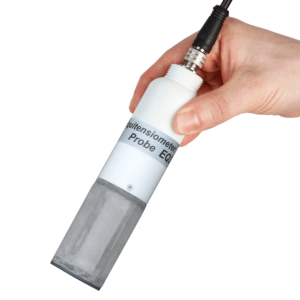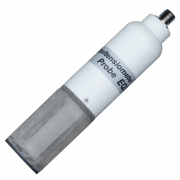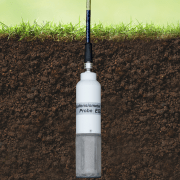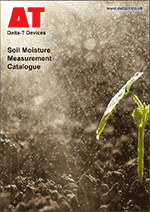- Overview
- Specification
- Accessories
- Product Resources How to Buy
- Convenient, accurate and reliable alternative to water-filled tensiometers
- Excellent range 0 to -1000 kPa
- Maintenance free: no refilling, degassing, or topping up
- Built in temperature sensor
- Buriable and frost resistant (IP68)
The EQ3 Equitensiometer uses class leading ThetaProbe technology to avoid the many problems of water-filled tensiometers. It measures water potential (matric potential) in the range 0 to -1000 kPa and provides an accurate loggable output. It is particularly well suited for use in dry soils.
How it works
The EQ3 tensiometer offers maintenance-free operation over a wide soil water potential range. It provides reliable matric potential measurements as well as soil temperature.
The EQ3s measuring rods are embedded in a porous material (the equilibrium body). This material has a known, stable relationship between water content and matric potential. When the EQ3 tensiometer is inserted into the soil, the matric potential within the equilibrium body equilibrates to that of the surrounding soils. The water content of the matric material is measured directly by the EQ3, and this can be converted into the matric potential of the surrounding soil using the calibration curve supplied with each Equitensiometer.
Installation and usage
The EQ3 Tensiometer is buriable (IP68) and maintenance-free. It can be inserted into augured holes or positioned in the wall of a trench (which is then carefully back-filled). Optional extension tubes assist placement and removal when burying at depth.
The EQ3 is rugged, maintenance-free (no refilling, degassing, or topping up required), frost resistant and low powered; this means it can left installed at remote sites over long periods of time. In such instances it is possible to access sensor data wirelessly via a modem, using a data logger such as the Delta-T GP2.
Please note that despite its many strengths, the EQ3 should not be seen as a rapid response sensor that covers the full range of water potentials at high accuracy. Such a sensor does not yet exist. EQ3 equilibration time is typically several hours.
Applications
The EQ3 Equitensiometer is ideally suited to static long term monitoring of water potential in soils and substrates. It can even be left installed in frozen soils. Typical applications include environmental, plant, soil, ecology and geo-sciences research, as well as civil engineering and agricultural engineering applications.
The EQ3’s full range is 0 to -1000 kPa but best accuracy is achieved between -100 and -500 kPa. This makes it well suited to plant water stress studies – even in very dry soils.
Data logging
The EQ3 can be logged by any Delta-T data logger, including the powerful GP2. It is also compatible with many other manufacturers’ data loggers. The EQ3 can also be used with an HH2 Moisture Meter, but only the unconverted millivolt output is displayed, and the temperature reading is not available.
Specification
| Measurement | Soil water potential (matric potential) and soil temperature |
| Accuracy | ± 10 kPa over 0 to -100 kPa 10% of reading over -100 to -1000 kPa |
| ± 0.5°C (0 to 40°C for temp sensor) ± 0.75°C (-20 to +60°C for temp sensor) | |
| Soil moisture measurement range | 0 to -1000 kPa (-10bar) |
| Salinity range | Suitable for all non-saline soils |
| Temperature range | 0 to 40°C |
| Output | 0 to 1.0 V differential, non-linear (Calibration data and graph supplied with each sensor) |
| Resistance 5.8Ω to 28Ω for temp sensor | |
| Power requirement | 5-14 V, ~18 mA for 1 s |
| Environmental | IP68 |
| Sample volume | N/A |
| Dimensions and weight | 181 x 40.5 mm diameter weight: 0.3 kg (excl. cable) |
| Sensor calibrations | Individual sensor calibrations supplied Recalibration advised every 2 years (depending on use) |
| Soil calibrations | No soil calibrations required |
Accessories
Hardware
Main components and software
Mountings and enclosures
Installation accessories
Cables and networks
Remote communications
Spares and consumables
Power options
Other
Product Resources
Data Sheets
Software
Manuals
- EQ3 Equitensiometer User Manual 1 MBFilename: eq3-user-manual-v1-1
FAQs
-
Setting up an M12 cable network to ensure a waterproof and secure connection.
Question
What is the best practice for setting up a M12 cable network to ensure a waterproof and secure connection..
Answer
It applies to:
GP2 for SDI-12 and logger networks.
Celora for SDI-12 networks.
All sensors with M12 connector cables.Examples of SDI-12 network and GP2 logger networks:
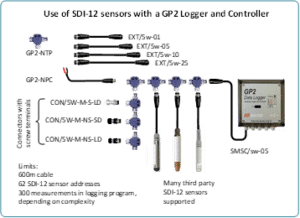
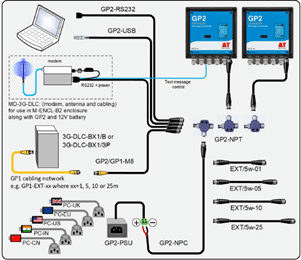
DO
When connecting multiple cables and T-piece together, it is essential that any M12 connector is tightened sufficiently:• Ensure internal connector O-ring and opposite sealing face are free from dirt.• Tighten the connector thumbscrews as much as you can by hand or use a torque driver set to 1Nm to be sure. See video:
We recommend the Weidmuller ‚”1900021000″ torque driver:
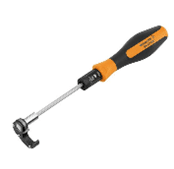
• This will save lots of painstaking troubleshooting hours if you do have a loose connection and give you piece of mind that all connectors are correctly tightened.
• Untightened connectors can come undone and let water into the cable network which can damage wire cores and cause erroneous readings.
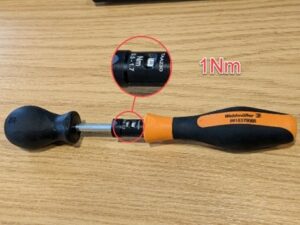
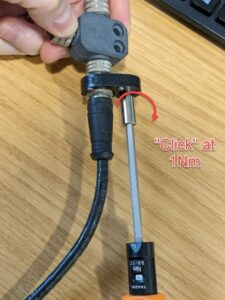
Connect in the office first and then transfer the network to the field. This way, you’re not trying to do it in unpleasant weather and the time pressures are off.
DON’T
Use duct tape. This will hold water against the connector. If tightened correctly, the connector will seal and hold.
Sensor Calibration File Locator
Input your 5 or 6 digit serial number below (do not include a slash, space or any letters) to download your EQ3 Sensor calibration file. (Example: 001024).
The serial number can be found on the label wrapped around the sensor body. Contact tech.support@delta-t.co.uk if your serial number is not recognised - and we will assist you directly



